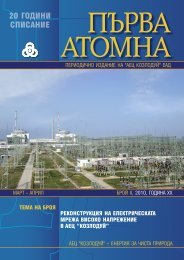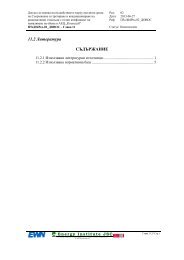Summary Report for Conduct of Kozloduy NPP Stress Tests
Summary Report for Conduct of Kozloduy NPP Stress Tests
Summary Report for Conduct of Kozloduy NPP Stress Tests
Create successful ePaper yourself
Turn your PDF publications into a flip-book with our unique Google optimized e-Paper software.
“<strong>Kozloduy</strong> <strong>NPP</strong>” PLC<br />
SUMMARY REPORT<br />
<strong>for</strong> <strong>Conduct</strong> <strong>of</strong> <strong>Kozloduy</strong> <strong>NPP</strong><br />
<strong>Stress</strong> <strong>Tests</strong><br />
2.10.4 Evaluation <strong>of</strong> safety margins against earthquake <strong>for</strong> SFS<br />
The SFS margin is at least 0,16g or 80% considering RLE (PGA=0.2 g), i.e. SFS can bear<br />
without fuel damage at an earthquake by 1,8 times greater than the RLE re-evaluated and valid as<br />
per 30.06.2011.<br />
2.10.4.1 Assessment <strong>of</strong> the seismic impact leading to severe fuel damage.<br />
Based on the analysis per<strong>for</strong>med in [44] it can be concluded that with the restrictions placed<br />
in [45] SFS can per<strong>for</strong>m the functions <strong>for</strong> safe storage <strong>of</strong> the spent fuel up to seismic impact in the<br />
range <strong>of</strong> 0.36 – 0.39 g, after which collapse <strong>of</strong> the main support structure occurs and the capability<br />
<strong>of</strong> the building <strong>for</strong> natural ventilation <strong>of</strong> the pool cooling fails. Extension <strong>of</strong> the time <strong>for</strong> safe storage<br />
<strong>of</strong> the fuel in this situation depends on the possibility <strong>for</strong> cleaning the construction debris and<br />
recovery, if possible, the natural ventilation.<br />
2.10.4.2 Evaluation <strong>of</strong> the seismic with loss <strong>of</strong> SFS integrity<br />
According to the approach applied in analysis [44] seismic accelerations at which it is<br />
accepted that the structure integrity fails and it cannot ensure natural air circulation required <strong>for</strong> the<br />
fuel damage were defined. The following values are obtained:<br />
· destructive acceleration <strong>for</strong> columns by row D (190/50 cm) – 0.39 g;<br />
· destructive acceleration <strong>for</strong> columns by row (60/50 cm) – 0.44 g.<br />
There<strong>for</strong>e, in the below part <strong>of</strong> the considered range <strong>of</strong> seismic acceleration destruction <strong>of</strong><br />
the main support columns <strong>of</strong> SFS and falling <strong>of</strong> ro<strong>of</strong> and the cranes over the pools cover can be<br />
anticipated. This may potentially lead to damage to the shells storing the fuel and to damage <strong>of</strong> the<br />
rein<strong>for</strong>ced concrete structure <strong>of</strong> the pools coupled with significant leaks in the damaged sections.<br />
2.10.4.3 Scenario with beyond design basis earthquake followed by the beyond design basis<br />
flooding<br />
According to the results <strong>of</strong> [89], there are no SSCs that will be affected by the MWL.<br />
There<strong>for</strong>e, <strong>for</strong> this nuclear installation scenario with combination <strong>of</strong> beyond design basis earthquake<br />
and beyond design basis flooding as the effect <strong>of</strong> external events is defined in the framework <strong>of</strong><br />
[63].<br />
2.10.4.4 Measures to enhance robustness <strong>of</strong> SFS<br />
With regard to SFS measures to increase robustness are not proposed as its margin is fully<br />
dependent on the capacity <strong>of</strong> the civil structure.<br />
100/202

















